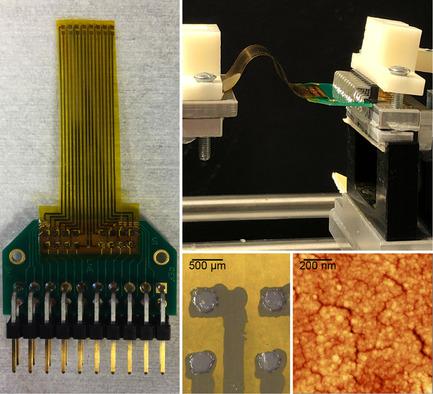当前位置:
X-MOL 学术
›
Adv. Eng. Mater.
›
论文详情
Our official English website, www.x-mol.net, welcomes your feedback! (Note: you will need to create a separate account there.)
All‐Printed Electrocorticography Array for In Vivo Neural Recordings
Advanced Engineering Materials ( IF 3.6 ) Pub Date : 2020-01-27 , DOI: 10.1002/adem.201901403 Eleonora Borda 1 , Laura Ferlauto 1 , Jürg Schleuniger 2 , Alessandro Mustaccio 2 , Fabian Lütolf 2 , Arnold Lücke 2 , Sören Fricke 2 , Nenad Marjanović 2 , Diego Ghezzi 1
Advanced Engineering Materials ( IF 3.6 ) Pub Date : 2020-01-27 , DOI: 10.1002/adem.201901403 Eleonora Borda 1 , Laura Ferlauto 1 , Jürg Schleuniger 2 , Alessandro Mustaccio 2 , Fabian Lütolf 2 , Arnold Lücke 2 , Sören Fricke 2 , Nenad Marjanović 2 , Diego Ghezzi 1
Affiliation

|
Bioelectronic and neuroprosthetic interfaces rely on implanted microelectrode arrays (MEAs) to interact with the human body. Printing techniques, such as inkjet and screen printing, are attractive methods for the manufacturing of MEAs because they allow flexible, room‐temperature, scalable, and cost‐effective fabrication processes. Herein, the fabrication of all‐printed electrocorticography arrays made by inkjet printing of platinum and screen printing of polyimide is shown. Next, mechanical and electrochemical characterizations are performed. As a proof of concept, in vivo visually evoked cortical potentials are recorded in rabbits upon flash stimulation. Lastly, it is shown that the all‐printed electrocorticography arrays are not cytotoxic. Altogether, the results enable the use of printed MEAs for neurological applications.
中文翻译:

用于体内神经记录的全印刷脑电图阵列
生物电子和神经假体界面依靠植入的微电极阵列(MEA)与人体相互作用。喷墨技术和丝网印刷等印刷技术是制造MEA的有吸引力的方法,因为它们允许灵活,室温,可扩展且具有成本效益的制造过程。在此,显示了通过铂的喷墨印刷和聚酰亚胺的丝网印刷制成的全印刷皮层成像阵列的制造。接下来,进行机械和电化学表征。作为概念的证明,在闪光刺激下在兔中记录了体内视觉诱发的皮层电位。最后,表明全印刷的皮层成像阵列没有细胞毒性。总而言之,该结果使得能够将印刷的MEA用于神经系统应用。
更新日期:2020-01-27
中文翻译:

用于体内神经记录的全印刷脑电图阵列
生物电子和神经假体界面依靠植入的微电极阵列(MEA)与人体相互作用。喷墨技术和丝网印刷等印刷技术是制造MEA的有吸引力的方法,因为它们允许灵活,室温,可扩展且具有成本效益的制造过程。在此,显示了通过铂的喷墨印刷和聚酰亚胺的丝网印刷制成的全印刷皮层成像阵列的制造。接下来,进行机械和电化学表征。作为概念的证明,在闪光刺激下在兔中记录了体内视觉诱发的皮层电位。最后,表明全印刷的皮层成像阵列没有细胞毒性。总而言之,该结果使得能够将印刷的MEA用于神经系统应用。



























 京公网安备 11010802027423号
京公网安备 11010802027423号